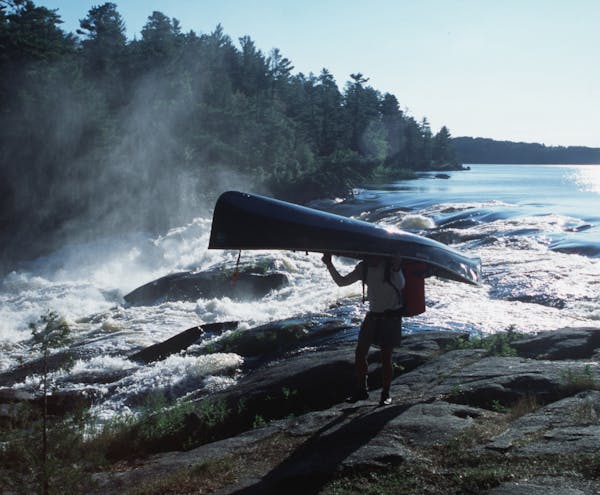On the first Sunday in May, a great horned owlet fell from its nest in Como Park. The chick was only a few weeks old — so young that it had no feathers yet, but was still covered in fluffy white down. It weighed less than a pound.
It was, of course, a bird, so it had no idea that an entire neighborhood had been awaiting its arrival. It had no idea that when it fell, it broke a lot of hearts.
An owl-filled winter
Every night this long cold winter, I walked past a silver maple near the park Conservatory. A pair of great horned owls had nested there the year before in a cavity created by a broken branch, and I hoped they would nest there again. But owls don't always reuse old nests, and so I kept watch in December and January as the pair hooted and flew, staking out their territory, getting ready to mate.
As it turned out, I wasn't the only one paying attention. Once in a while, as I approached the tree on my evening walk, I spotted someone else quietly listening in the dark.
I had lived in the Como area for 20 years and I thought I knew all my neighbors, but because of the owls, over the winter I met many more. We stopped on the walking path and exchanged owl reports. We tagged each other in Facebook photos of the birds. We e-mailed when we had owl news.
Great horned owls are early nesters, and the female is usually sitting on eggs by February, but all that month, the nest remained empty. Were the owls nesting somewhere else? Had they moved on? Still, many nights I heard hooting, and I had hope.
A late clutch
On March 14, I looked up and saw ear tufts and yellow eyes: At last, the female was brooding. After that I saw her every day; she hardly ever moved. I took picture after picture of those ear tufts, as did my neighbors, who began joking that what we were seeing was not an owl at all, but a cardboard cutout.
As we slogged through a cold, wet March and into a cold, wet April, the female remained steadfast. Every morning, ear tufts and yellow eyes. The male was usually nearby: It was his job to bring her food — squirrels, rabbits, rats, dropped into the cavity at her side. Her job was to sit still and keep those eggs warm.
Finally, in mid-April, a neighbor posted a picture of her upside down in the nest, and we cheered: She must be feeding babies!
On the first Saturday in May, I was rewarded with a glimpse. The male owl, corpulent and sleepy-eyed, was in the branches of a nearby pine. The female was out of the nest, perched on a branch in the silver maple, watchful and alert.
For a long time, I stared at the cavity. And then — peekaboo! — a puff of white, so fast I almost didn't see it. It rose above the rim and then sank down. A minute later, another peek.
The owlet was tiny and fluffy, only its eyes and beak visible as it popped up and rapidly descended. Clearly, I thought, this baby wants to see the world. Well, we wanted to see him, too. After a few minutes, the peeking stopped. The female swooped off to a stand of pines. I walked on. And that was it. The next day, the owlet fell to its death.
A mysterious fall
A neighbor was biking past on Sunday afternoon when he saw the owlet on the ground. The Raptor Center came and took the bird in hopes of saving its life, and the neighbor went home and alerted us via Facebook. Right away, dozens of comments, all distraught.
When I called the Raptor Center in the morning, they told me that the owlet had not survived. It had severe bruising on its legs and abdomen, which was unusual. Owlets often fall from the nest or branch, they told me, and their soft down normally serves as excellent padding. But perhaps this owlet had gotten bumped as it fell, or perhaps it had been grabbed by a predator.
After their chick died, there was no reason for the parents to stay. The female disappeared almost immediately. The male stayed for a few days, but soon he, too, was gone.
The nest was empty. There were no other owlets inside.
The owlet's gift
Is it strange to mourn a bird — a baby bird that you have glimpsed only once? But mourn we did, and as we grieved, we tried to make sense of our attachment and our loss.
Those hooting owls had made the winter magical. I thrilled to see them near the silver maple, or hunting at night off the Conservatory's illuminated dome. I enjoyed swapping stories about them and getting to know my neighbors better.
I'm sorry that we won't get to watch the owlet grow, sorry that the mother's weeks of patient brooding were for naught. Nature has cycles, but that doesn't mean that nature is predictable. Wild babies often die. I had counted on this owlet, and I should not have.
Still, it's hard to live so close to nature and not feel hope in its rhythms. Come November, I will be out there, walking the paths, listening for hoots, foolishly confident of babies in the spring.
Laurie Hertzel • 612-673-7302

Twins scrape past White Sox 6-5 with two-run ninth inning
Suns guard Grayson Allen aggravates ankle injury vs. Timberwolves. Phoenix falls into 0-2 hole

Neal: 'Wolves in four'? Fans' chant could prove correct.
Logan Webb extends scoreless streak to 19 innings as the Giants send the Mets to 3rd straight loss

